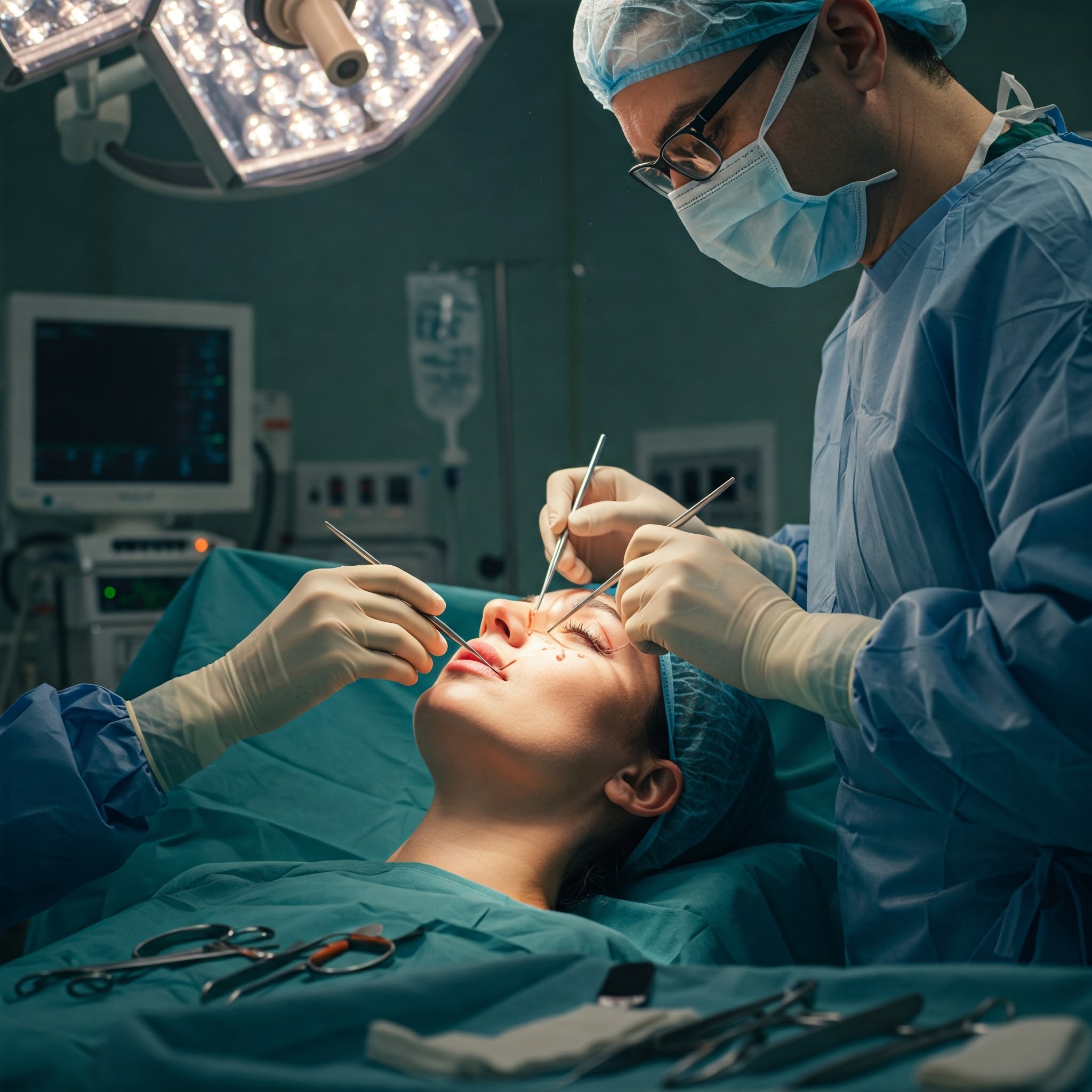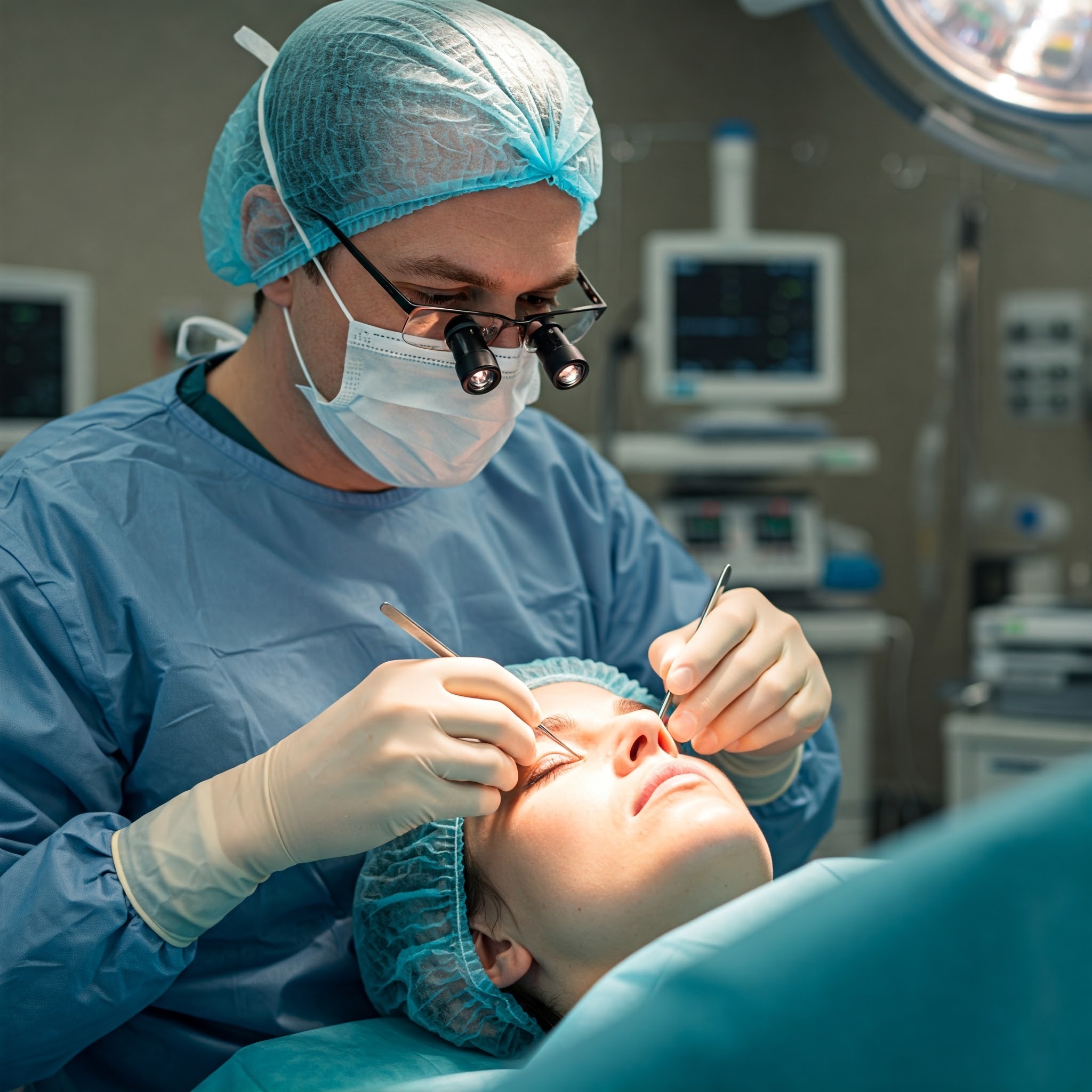Rhinoplasty & Eyelid Surgeries
Enhance your facial aesthetics with rhinoplasty and eye-lid surgery
Achieve natural, youthful results with expert rhinoplasty and eyelid surgery
At neo-Woman, we specialize in rhinoplasty (nose surgery) and blepharoplasty (eyelid surgery) to enhance your facial appearance and restore youthful vitality. Rhinoplasty, commonly known as a nose job, is a surgical procedure that can reshape and refine the nose to improve both its aesthetic appearance and functionality. Whether you want to correct a misshapen nose, reduce size, or improve breathing, our skilled surgeons use advanced techniques to provide natural-looking results tailored to your face.
Eyelid surgery (blepharoplasty) is designed to rejuvenate the eyes by removing excess skin and fat from the upper and lower eyelids, reducing puffiness and wrinkles. This procedure can help correct sagging eyelids, making you look more rested, refreshed, and youthful. Eyelid surgery can also improve vision by removing obstructions caused by drooping eyelids, offering both functional and cosmetic benefits.
At neo-Woman, we understand the impact that rhinoplasty and eyelid surgery can have on your confidence and self-esteem. Our experienced surgeons will work with you to develop a personalized treatment plan to achieve the best results. From the initial consultation to post-operative care, we are committed to providing comprehensive support and guidance throughout your journey.


Facial harmony meets expert surgical care
At neo-Woman, we offer specialized rhinoplasty (nose surgery) and blepharoplasty (eyelid surgery) to help you enhance facial harmony and restore a more youthful, refreshed appearance. Whether you’re looking to refine the shape of your nose or rejuvenate tired, drooping eyelids, our experienced surgeons are here to guide you through the process and help you achieve your aesthetic goals with precision and care.
- Understanding rhinoplasty
Rhinoplasty, also known as a nose job, comes in various types to meet different cosmetic and functional goals. Cosmetic rhinoplasty focuses on enhancing the nose’s appearance by refining its shape, size, or symmetry. Functional rhinoplasty addresses breathing issues by correcting structural problems, such as a deviated septum.
Revision rhinoplasty is performed to correct or improve previous nasal surgeries. There are two primary techniques: open rhinoplasty, which involves making an incision across the columella (the area between the nostrils), and closed rhinoplasty, which is done through incisions inside the nose. The choice of technique depends on the complexity of the procedure and the surgeon’s expertise, ensuring personalized and natural-looking results.
Here are some of the check up and health screenings that you should get done:
- Pelvic Exam
- Pap Smear (Cervical Cancer Screening)
- Breast Exam
- Blood Pressure Measurement
- Cholesterol Screening
- Bone Density Scan (DXA)
- Blood Sugar Test (Glucose Screening)
- Thyroid Function Tests
- Blood Count (Complete Blood Count, CBC)
* The specific exams and screenings recommended can vary based on a woman’s age, family history, personal health history, and risk factors. It’s essential to discuss your individual healthcare needs and screening schedule with your healthcare provider.
- Rhinoplasty procedure
Rhinoplasty begins with a thorough consultation to assess your goals and examine your nose structure. The procedure typically takes 1-3 hours, performed under general anesthesia or local anesthesia with sedation.
The surgeon will reshape the bone and cartilage, making incisions either inside the nose or across the columella. For functional cases, the surgeon may also address internal issues, like a deviated septum. After the procedure, patients are usually given a nasal splint to support healing. The recovery period involves swelling and bruising, which can take a few weeks to subside. The final results become visible after several months, as the swelling fully resolves, revealing a balanced and refined nose.
- Blepharoplasty (eyelid surgery)
Blepharoplasty, or eyelid surgery, is a procedure designed to address common aging signs around the eyes, such as sagging skin, puffiness, and excess fat. Upper eyelid surgery removes drooping skin that can obstruct vision, while lower eyelid surgery targets under-eye bags, excess skin, and wrinkles.
This procedure can create a more youthful, alert appearance by lifting and tightening the eyelid skin. For functional reasons, blepharoplasty can also improve peripheral vision when eyelid sagging is severe. The procedure is typically done under local anesthesia with sedation, and recovery usually takes about a week. Afterward, patients can enjoy rejuvenated eyes with a natural, refreshed look.
- Recovery and aftercare
Recovery after rhinoplasty and blepharoplasty requires careful attention to ensure optimal healing. For rhinoplasty, patients should keep their head elevated to reduce swelling and avoid strenuous activity for several weeks. Cold compresses can help minimize bruising, and pain can be managed with prescribed medication.
After blepharoplasty, it’s essential to avoid rubbing the eyes and wearing makeup for a few weeks. Swelling and bruising typically subside within a week to 10 days. Both procedures require follow-up appointments to monitor progress and ensure proper healing. Adhering to aftercare instructions is crucial for achieving the best results, which will continue to improve over several months as swelling completely resolves.
- Is rhinoplasty and blepharoplasty right for you?
Rhinoplasty and blepharoplasty are ideal for individuals looking to enhance their facial appearance by correcting nasal or eyelid concerns. Rhinoplasty is suitable for those who wish to refine their nose shape, improve symmetry, or correct breathing issues.
Blepharoplasty is recommended for individuals experiencing drooping eyelids, under-eye bags, or skin that impairs vision. Ideal candidates are generally healthy, non-smokers with realistic expectations. It’s essential to consult with a qualified surgeon to determine if these procedures align with your cosmetic or functional goals. The surgeon will assess your facial features, medical history, and desired outcomes to develop a personalized treatment plan for you.

Frequently asked questions
How long do rhinoplasty and blepharoplasty results last?
Both rhinoplasty and blepharoplasty offer long-lasting results, though rhinoplasty results are permanent, as the nose’s structure is permanently reshaped. However, as you age, minor changes in skin elasticity and nasal tissue may occur. Blepharoplasty results can last many years, but natural aging may lead to some loosening of the eyelid skin over time. Maintaining a healthy lifestyle can help preserve your results longer.
Can I wear contact lenses or glasses after rhinoplasty or blepharoplasty?
After rhinoplasty, it’s advised to avoid wearing glasses for a few weeks to prevent pressure on the nose and to allow healing. After blepharoplasty, patients can typically resume wearing contact lenses after a few days, but glasses should be avoided for at least 1–2 weeks. Always follow your surgeon’s post-operative guidelines to ensure proper healing.
Is there a difference in recovery times between rhinoplasty and blepharoplasty?
The recovery time for rhinoplasty is typically longer than for blepharoplasty. While both procedures may involve some swelling and bruising, rhinoplasty can take 1-2 weeks for the initial healing, with complete results visible after 6-12 months. Blepharoplasty usually requires about 7-10 days of recovery, with most swelling and bruising subsiding in the first week. However, full healing may take several months for both procedures.
Will I experience pain after rhinoplasty or blepharoplasty?
Both rhinoplasty and blepharoplasty are relatively well-tolerated procedures, and patients typically experience mild to moderate discomfort during the recovery period. Pain is usually managed with prescribed medications and can be alleviated with cold compresses. Swelling, bruising, and tightness are more common post-surgery symptoms, but these subside over time. Always follow your surgeon’s post-op care instructions for the best results and minimal discomfort.
Can rhinoplasty and blepharoplasty be combined with other facial procedures?
Yes, rhinoplasty and blepharoplasty are often combined with other facial procedures to enhance overall facial aesthetics. Many patients opt to combine these surgeries with facelifts, chin augmentation, or dermal fillers for more comprehensive rejuvenation. Combining procedures can reduce the number of surgeries and recovery time. However, it’s important to consult with a skilled surgeon to ensure the treatments complement each other and align with your cosmetic goals.

Service line
Our locations
Neo-woman clinic
Jm road
1277 renaissance, 1st floor,j m road, nest to mcdonalds, deccan gymkhana, pune contact us at: 8888576666
Our locations
Neo-woman clinic hadapsar Jm road
Gandharva empire, 3rd floor, above fab india, raskar chowk, amanora park, hadapsar, pune contact us at: 7030114488
Copyright © 2025 neowoman – all rights reserved.
:::|Powered by Dimakh Consultants |:::